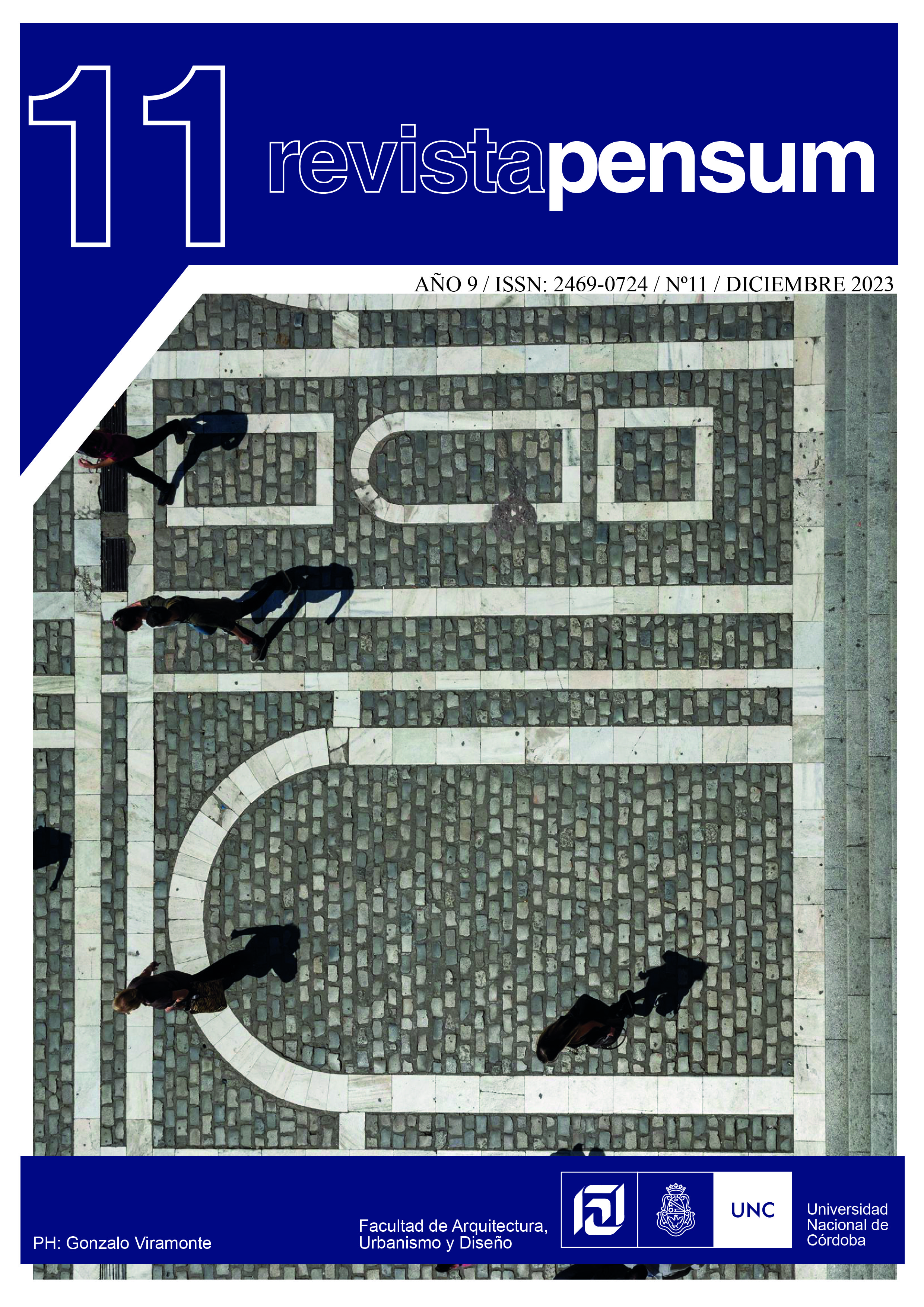Place attachment in heterotopic spaces
theoretical reflection in the postmodern city
DOI:
https://doi.org/10.59047/2469.0724.v9.n11.41082Keywords:
place attachment, heterotopia, postmodern city, Fundidora park, urban spacesAbstract
The emotional connection between people and the places they inhabit is crucial in the design, intervention, and understanding of urban spaces. This article aims to capture Foucault's notions of heterotopia as a theoretical framework to address attachment to place in the material and symbolic reality of postmodern cities. The article investigates the theoretical and conceptual interconnections between the dimensions of attachment to place and heterotopias and and its implications at the city scale. The problem addressed stems from the scarce research on the construction of attachment to place in heterotopic spaces. The characterization of an urban park in the city of Monterrey as a heterotopia is presented, along with its significance for studying attachment to place in this environment. The results highlight the importance of an analysis from heterotopic spaces as a strategy to understand the functioning of attachment to place in the complexity of postmodern cities. A valuable contribution is provided in the considerations for studying the role of attachment to place as a dynamic and multiscale phenomenon in today's society.
Downloads
References
Alonso, M. (2014). Los territorios de los otros: memoria y heterotopía. Cuicuilco Revista de Ciencias Antropológicas, 21(61), 333-352.
Alonso, M. [ RETEC DITET]. (2016 Junio 29). Heterotopías del territorio. Dra. María García Alonso. Profesora UNED. [Video]. YouTube https://www.youtube.com/watch?v=htw2r4QF8kQ&ab_channel=RETECDITET
Altman, I., & Low, S. (Eds.). (1992). Place Attachment. Plenum Press. DOI: https://doi.org/10.1007/978-1-4684-8753-4
Amendola, G. (2000). La ciudad postmoderna. Magia y miedo de la metrópoli contemporánea, Celeste.
Augé, M. (2000). Los no lugares. Espacios del anonimato. Una antropología de la sobremodernidad, Gedisa.
Batista da Costa, E., & Alvarado-Sizzo, I. (2019). Heterotopía patrimonial: concepto para estudios latinoamericanos. Revista Electrónica de Geografía y Ciencias Sociales Universitat de Barcelona, 23 (620), 1-31. https://doi.org/10.1344/sn2019.23.22329. DOI: https://doi.org/10.1344/sn2019.23.22329
Baudrillard, J. (1994). Simulacra and simulation. University of Michigan Press. DOI: https://doi.org/10.3998/mpub.9904
Bauman, Z. (2003). Modernidad liquida. Fondo de Cultura Económica de Argentina.
Berroeta, H., Pinto L., Di Masso, A., & Ossul-Vermeheren, I. (2017). Apego al Lugar: una aproximación psicoambiental a la vinculación afectiva con el entorno en procesos de reconstrucción del hábitat residencial. Revista INVI 32 (91), 113-139. http://dx.doi.org/10.4067/S0718-83582017000300113 DOI: https://doi.org/10.4067/S0718-83582017000300113
Blake, K. (1999). Peaks of Identity in Colorado’s San Juan Mountains. Journal of Cultural Geography, 18, 29-55. DOI: https://doi.org/10.1080/08873639909478303
Canter, D. (1977). The Psychology of Place, St Martin’s Press.
Chamlee-Wright, E., & Storr, V. (2009). “There’s No Place like New Orleans”: Sense of Place and Community Recovery in the Ninth Ward after Hurricane Katrina. Journal of Urban Affairs, 31, 615-634. https://doi.org/10.1111/j.1467-9906.2009.00479.x DOI: https://doi.org/10.1111/j.1467-9906.2009.00479.x
Corijn, E. (2011). Construyendo (la capital de) Europa como una heterotopía. Revista CIDOB d’Afers Internacionals, 95, 43-57. https://doi.org/10.24241/rcai.vi95.245372
Debord, G. (1995). La sociedad del espectáculo. Ediciones Naufragio.
Dehaene, M., & De Cauter, L. (Eds.). (2008). Heterotopia and the City: Public Space in a Postcivil Society. Routledge. DOI: https://doi.org/10.4324/9780203089415
Di Masso, A., Williams, D., Raymond, C., Buchecker, M., Degenhardt, B., Devine‐Wright, P., Hertzog, A., Lewicka, M., Manzo, L., Shahrad, A., Stedman, R., Verbrugge, L., & Von Wirth, T. (2019). Between fixities and flows: navigating place attachments in an increasingly mobile world. Journal of Environmental Psychology, 61, 125-133. https://doi.org/10.1016/j.jenvp.2019.01.006 DOI: https://doi.org/10.1016/j.jenvp.2019.01.006
Dreyfus, H., & Rabinow, P. (1983). Michel Foucault: Beyond Structuralism and Hermeneutics. The American Historical Review, 88(3), 648-649. https://doi.org/10.2307/1864593 DOI: https://doi.org/10.2307/1864593
Durán, J. (2008). El Paseo Santa Lucía. una crónica del paisaje por el usuario. Contexto, (2), 19-21.
Ema López, J. (2004). Del sujeto a la agencia (a través de lo político). Athenea Digital. Revista de Pensamiento e Investigación Social, 5, 1-24. DOI: https://doi.org/10.5565/rev/athenea.114
Faubion, J. (2008) Heterotopia: an ecology. En M. Dehaene y L. De Cauter (Ed.), Heterotopia and the City: Public Space in a Postcivil Society, 43-52. DOI: https://doi.org/10.4324/9780203089415-9
Foucault, M. (1997). Los espacios otros. Astrágalo: Cultura de la Arquitectura y la Ciudad, 7, 83-91. DOI: https://doi.org/10.12795/astragalo.1997.i07.08
Girón, A. (2019). La anomalía urbana como lugar de oportunidad social: el caso de la Fábrica Bavaria Zona Techo, Bogotá [Tesis de Maestría, Universidad de los Andes] Séneca Repositorio Institucional. https://repositorio.uniandes.edu.co/entities/publication/316878fe-3201-4480-b3eb-9deb5e09ec62
González, S. (2017). Del acero al evento. Territorio postindustrial en transformación: caso de estudio Parque Fundidora, Monterrey [Tesis de Maestría, Universidad de los Andes] Séneca Repositorio Institucional. https://repositorio.uniandes.edu.co/entities/publication/b4d3abc0-dc8c-40be-b339-50207d27a5db
Goode, E. (2018). The taming of New York’s Washington Square: A Wild Civility. NYU Press.
Harvey, D. (2004). La condición de la posmodernidad. Investigación sobre los orígenes del cambio cultural. Amorrortu.
Hatz, G. (2018). Foucault’s Concept of Heterotopia as an Èpistemé for Reading the Post-Modern City: The Viennese Example. Current Urban Studies, 6, 455-482, https://doi.org/10.4236/cus.2018.64025 DOI: https://doi.org/10.4236/cus.2018.64025
Hernández, B. (2021). Place Attachment: Antecedents and consequences (Antecedentes y consecuencias del apego al lugar). Psyecology, 12(1), 99-122. https://doi.org/10.1080/21711976.2020.1851879 DOI: https://doi.org/10.1080/21711976.2020.1851879
Hernández, B., Hidalgo, C. & Ruiz, C. (2014). Theoretical and Methodological Aspects of research on Place Attachment. En L. Manzo & P. Devine-Wright (Eds.). Place Attachment: Advances in Theory, Methods, and Applications (94-110). Routledge. DOI: https://doi.org/10.4324/9780429274442-6
Hetherington, K. (1997). The Badlands of modernity: Heterotopia and Social Ordering. Routledge.
Heynen, H. (2008). Heterotopia Unfolded? En M. Dehaene, & L. De Cauter (Eds.). Heterotopia and the City. Public Space in a Postcivil Society (311-323). Routledge. DOI: https://doi.org/10.4324/9780203089415-36
Hidalgo, M. & Hernández, B. (2001). Place attachment: conceptual and empirical questions. Journal of Environmental Psychology, 21(3), 273-281. https://doi.org/10.1006/jevp.2001.0221 DOI: https://doi.org/10.1006/jevp.2001.0221
Hidalgo, M., Moreno-Jiménez, P., Muiños, G., & Hernández, B. (2020). Neighborhood care and neighborhood bonds: an unequal relationship. Environment and Behavior, 53(6), 571-600. https://doi.org/10.1177/0013916520937453 DOI: https://doi.org/10.1177/0013916520937453
Hilaluddin, R., Ujang, N., & Maulan, S. (2018). Influence of demographic factors on the preference of future Kuala Lumpur Riverfront. International journal of scientific and research publications, 8(8), 366-374. https://doi.org/10.29322/ijsrp.8.8.2018.p8045 DOI: https://doi.org/10.29322/IJSRP.8.8.2018.p8045
Hinojosa, A. & Martínez, E. (2019). La patrimonialización del Parque Fundidora, en Monterrey, Nuevo León. Humanitas Digital, 45, 141–159.
Jackson, J. (1994). A sense of place, a sense of time. Yale University Press. DOI: https://doi.org/10.2307/4091350
Jameson, F. (1991). El posmodernismo o la lógica cultural del capitalism tardío. Ediciones Paidós.
Johnson, P. (2006). Unravelling Foucault's 'different spaces'. History of the Human Sciences (19), 75-90. https://doi.org/10.1177/0952695106069669 DOI: https://doi.org/10.1177/0952695106069669
Johnson, P. (2010). On Heterotopia. [Tesis de Doctorado, University of Bristol] Explore Bristol Research. https://research-information.bris.ac.uk/ws/portalfiles/portal/34506052/531682.pdf
Johnson, P. (2013). The geographies of Heterotopia. Geography Compass, 7(11), 790-803. https://doi.org/10.1111/gec3.12079 DOI: https://doi.org/10.1111/gec3.12079
Kim, M. (2021). Plural and fluid place attachment amid tourism-induced neighborhood change in a disadvantaged neighborhood in Soth Korea, Geoforum, 121, 129-137. https://doi.org/10.1016/j.geoforum.2020.12.017. DOI: https://doi.org/10.1016/j.geoforum.2020.12.017
Lawson, B. (2001). The language of space. Routledge.
Lax, F. (1998). Heterotopia from a Biological and Medical Point of View, En R. Ritter & B. Knaller-Vlay (Eds.), Other Spaces. The Affair of the Heterotopia (114-123). Prachner.
Lewicka, M. (2005). Ways to make people active: role of place attachment, cultural capital and neighborhood ties. Journal of Environmental Psychology, 4, 381-395. https://doi.org/10.1016/j.jenvp.2005.10.004 DOI: https://doi.org/10.1016/j.jenvp.2005.10.004
Lewicka, M. (2011). Place attachment. Journal of Environmental Psychology, 31, 207-230. DOI: https://doi.org/10.1016/j.jenvp.2010.10.001
López, L. (2003). Geografía cultural y posmodernidad: nuevas realidades, nuevas metodologías. En P. Olivera (Ed.). Espacio geográfico. Epistemología y diversidad (193-208). Facultad de Filosofía y Letras, UNAM.
Lyotard, J. (1984). The Postmodern Condition: A Report on Knowledge. Manchester University Press. DOI: https://doi.org/10.2307/1772278
Marsh, B. (1987). Continuity and decline in the Anthracite Towns of Pennsylvania. Annals of Association of American Geographers, 77, 337-352. DOI: https://doi.org/10.1111/j.1467-8306.1987.tb00163.x
Morgan, P. (2009). Towards a developmental theory of place attachment. Journal of Environmental Psychology, 30, 11-22. DOI: https://doi.org/10.1016/j.jenvp.2009.07.001
Narváez, A. (2006). Ciudades difíciles. El futuro de la vida urbana frente a la globalización. Plaza y Valdés.
Parra, J. (2017). Imagen, virtualidad y heterotopía. Reflexiones acerca de la imagen y su función heterotópica. Civilizar, 17(32), 229–244. https://doi.org/10.22518/16578953.828 DOI: https://doi.org/10.22518/16578953.828
Perkins, D. & Long, D. (2002). Neighborhood Sense of Community and Social Capital. En A. Fisher, C. Sonn, B. Bishop (Eds.) Psychological Sense of Community: Research, Applications, and Implications (291–318). Springer. https://doi.org/10.1007/978-1-4615-0719-2_15 DOI: https://doi.org/10.1007/978-1-4615-0719-2_15
Prieto, J. (2011). La consolidación del Monterrey “imaginario” en el contexto de la globalización: “Macroproyectos” urbanos. Frontera Norte, 23 (45), 163-192.
Relph, E. (1969). Place and placelessness. Editorial Pion.
Rivera, S. (2021). La rebeldía de permanecer: un estudio del apego al espacio urbano en el caso de las cooperativas de vivienda en el Centro Histórico de San Salvador [Tesis de maestría, Universidad de Chile] Repositorio Académico de la Universidad de Chile https://repositorio.uchile.cl/handle/2250/178168 DOI: https://doi.org/10.51378/iuca.v1i1.6823
Sacco, P., Ghirardi, S., Tartari, M. & Trimarchi, M. (2019). Two versions of heterotopia: The role of art practices in participative urban renewal processes. Cities (89), 199-208 https://doi.org/10.1016/j.cities.2019.02.013. DOI: https://doi.org/10.1016/j.cities.2019.02.013
Sainz, V. (1997). La posmodernidad y el nacimiento de una nueva cultura urbana: Las aportaciones de Aldo Rossi [Tesis de Doctorado, Universidad de Sevilla] Depósito de Investigación Universidad de Sevilla.
Saldanha, A. (2008). Heterotopia and structuralism. Environment and Planning A: Economy and Space, 40(9), 2080-2096. https://doi.org/10.1068/a39336 DOI: https://doi.org/10.1068/a39336
Savage, M., Bagnall, M. & Longhurst, M. (2005). Globalization & Belonging. Sage Publications. DOI: https://doi.org/10.4135/9781446216880
Scannell, L. & Gifford, R. (2010). Defining place attachment: a tripartite organizing framework. Journal of Environmental Psychology, 30 (1), 1-10. https://doi.org/10.1016/j.jenvp.2009.09.006 DOI: https://doi.org/10.1016/j.jenvp.2009.09.006
Scannell, L. & Gifford, R. (2017). The experienced psychological benefits of place attachment. Journal of Environmental Psychology, 51, 256-269. DOI: https://doi.org/10.1016/j.jenvp.2017.04.001
Sloterdijk, P. (2006). Esferas III: Espumas. Esferología plural. Siruela.
Smith, J. (2019). Designing better cities through an understanding of place attachment. En J.A. Treviño & N. Rivera (Eds.) Identidad, economía y sociedad en el espacio humano (11-25). AM Editores
Smith, J. & White, B. (2004). Detached from their homeland: The Latter-Day Saints of Chihuahua, Mexico. Journal of Cultural Geography, 21, 57-76. DOI: https://doi.org/10.1080/08873639009478259
Soja, E. (1996). ThirdSpace: Journeys to Los Angeles and Other Real-and-Imagined Places. Wiley-Blackwell.
Soja, E. (2000). Postmetropolis: Critical Studies of Cities and Regions. Wiley-Blackwell.
Stokols, D. & Schumaker, S. (1981). People in places: A transactional view of settings. En J. Harvey (Ed.) Cognition, Social Behaviour, and the Environment, 441-488.
Topinka, R. (2010). Foucault, Borges, Heterotopia: Producing Knowledge in Other Spaces. Foucault Studies, 9, 54-70. DOI: https://doi.org/10.22439/fs.v0i9.3059
Tuan, Y. (1974). Topophilia. A study of environmental perception, attitudes and values. Prentice Hall Inc.
Tuan, Y. (1977). Space and place. The perspective of experience. Universidad de Minnesota Press.
Tuan, Y. (1980). Rootedness versus Sense of Place. Landscape, 24, 3-8.
Ujang, N. (2017). Place Attachment and continuity of Urban Place Identity. Social and Behavioral Sciences, 49, 156-167. DOI: https://doi.org/10.1016/j.sbspro.2012.07.014
Van Wyk, T. (2014). Church as heterotopia. Theological Studies/Teologiese Studies, 70(1), 1-7. https://doi.org/10.4102/hts.v70i1.2684 DOI: https://doi.org/10.4102/hts.v70i1.2684
Weil, S. (1952) The need for roots: Prelude to a declaration of duties toward Mankind. Routledge & Kegan Paul.
Published
How to Cite
Issue
Section
License
Copyright (c) 2023 Laura Valdés González, Amanda Melissa Casillas Zapata

This work is licensed under a Creative Commons Attribution-ShareAlike 4.0 International License.
Authors who publish in this journal agree to the following terms:
a. Authors retain copyright and guarantee to the journal the right to be the first publication of the work as well as licensed under a Creative Commons Attribution-ShareAlike 4 license.
b. Authors may separately establish additional agreements for non-exclusive distribution of the version of the work published in the journal (e.g., placing it in an institutional repository or publishing it in a book), with an acknowledgement of its initial publication in this journal.
c. Authors are permitted and encouraged to disseminate their work electronically (e.g., in institutional repositories or on their own website) before and during the submission process, as this may result in productive exchanges, as well as earlier and greater citation of published work (See The Effect of Open Access).
d. 4.0 International Creative Commons Attribution-ShareAlike 4.0 License.












